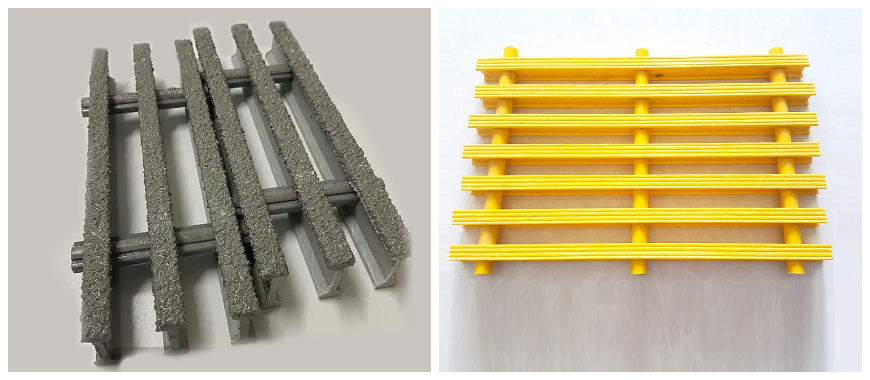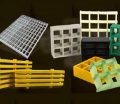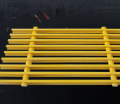
Iron grating is a vital component widely used in various applications, particularly in construction and industrial settings. Known for its exceptional durability and strength, it is designed to support heavy loads while providing a safe and stable surface for pedestrian and vehicular traffic. Its robust construction makes it ideal for high-traffic areas, such as walkways, platforms, and industrial flooring, where reliability is paramount. In addition to its functional benefits, this grating also offers aesthetic appeal, often enhancing the overall design of a space. The intricate patterns and finishes available can complement architectural elements while ensuring safety and performance in demanding environments. This combination of durability, strength, and visual attractiveness makes it a preferred choice in a variety of applications.
What is Iron Grating?
Iron gratings is a type of flooring or covering made from iron materials, designed to provide a sturdy and durable surface for various applications. It consists of a grid-like structure, typically formed from parallel bars that allow for the passage of light, air, and liquids while providing excellent support for pedestrian and vehicular traffic. Iron gratings are primarily used in industrial settings, construction projects, and public infrastructure, such as walkways, platforms, drainage covers, and access points. For instance, a galvanized walkway, often paired with iron grating, offers additional protection against corrosion, extending the lifespan of these surfaces in harsh environments.
Types of Iron Used in Grating
There are two main types of iron commonly used in the production of iron grating:
- Cast Iron: This type of iron is known for its high compressive strength and durability. Cast iron gratings is often used in heavy-duty applications where strength is paramount, such as in industrial environments and roadways. Its ability to withstand heavy loads and resist corrosion makes it a popular choice for outdoor use, especially in harsh weather conditions.
- Wrought Iron: Wrought iron gratings is characterized by its malleability and resistance to corrosion. It is often used in decorative applications, such as gates, railings, and architectural features, due to its aesthetic appeal. Wrought iron gratings can also be used in various structural applications, providing both strength and beauty.
Iron gratings plays a crucial role in various applications, offering durability and strength through the use of materials like cast iron and wrought iron. Its design allows for practical functionality while ensuring safety in high-traffic areas.
Understanding Floor Drain Grating
Types of Iron Grating
Iron grating is available in several types, each with its unique characteristics, advantages, and applications. Understanding these different types is essential for selecting the appropriate iron gratings for specific needs.
Cast Iron Grating
Features:
Cast iron grating is made from molten iron poured into molds, allowing for complex designs and high load-bearing capacities. The process creates a rigid and sturdy structure that can withstand significant weight.
Advantages:
- High Load Capacity: Cast iron gratings can support heavy loads, making it ideal for industrial applications.
- Durability: Resistant to wear and impact, it is suitable for high-traffic areas.
- Corrosion Resistance: It withstands outdoor conditions well, especially when treated or coated.
Applications:
Commonly used in industrial facilities, roadways, and drainage systems, cast iron gratings is often found in environments where heavy machinery operates or where durability is a priority.
Wrought Iron Grating
Characteristics:
Wrought iron gratings is manufactured by heating and shaping iron, resulting in a flexible and malleable material. This type of grating is often characterized by its decorative designs and aesthetic appeal.
Advantages:
- Malleability: Wrought iron can be easily shaped into intricate designs, making it perfect for architectural applications.
- Corrosion Resistance: Typically treated to enhance its ability to resist rust and deterioration.
- Aesthetic Appeal: Provides an attractive finish suitable for residential and decorative uses.
Common Uses:
Wrought iron gratings is often used in gates, railings, and ornamental features in both residential and commercial settings.
Comparison of Strengths and Weaknesses
- Cast Iron Grating:
- Strengths:
- Exceptional load-bearing capacity.
- Long-lasting durability in heavy-use environments.
- Weaknesses:
- Heavier than wrought iron, making it more challenging to handle.
- Can be brittle and susceptible to cracking under extreme stress.
- Wrought Iron Grating:
- Strengths:
- Lightweight and easier to work with.
- Highly versatile for decorative applications.
- Weaknesses:
- Generally lower load capacity compared to cast iron.
- May require more maintenance due to susceptibility to rust if not properly treated.
The different types of iron gratings, including cast iron and wrought iron, each offer unique features and advantages suitable for various applications. Understanding the strengths and weaknesses of each type allows for informed decisions when selecting iron gratings that best meets the specific requirements of a project. Whether the need is for heavy-duty support in industrial settings or aesthetic appeal in architectural designs, there is a suitable iron gratings solution available.
The Essential Guide to Riser Grating
Advantages of Iron Grating
Iron gratings offers numerous advantages that make it a preferred choice for various industrial and architectural applications. Its robust properties and versatility provide effective solutions for many needs. Here are the key benefits of using iron grating:
Key Benefits of Using Iron Grating
- Durability:
- Iron gratings is exceptionally durable and can withstand significant wear and tear, making it suitable for high-traffic areas.
- It is capable of supporting heavy loads, ensuring that it remains intact even under the weight of vehicles or heavy machinery.
- Corrosion Resistance:
- Iron grating can be treated with protective coatings such as galvanization, which enhances its resistance to rust and corrosion.
- This treatment extends the lifespan of iron gratings, making it ideal for outdoor applications or environments exposed to moisture and chemicals.
- Versatility:
- Iron gratings is highly versatile and can be used in various applications, including flooring, walkways, drainage systems, and as decorative elements in architectural designs.
- Its adaptability allows it to be used in both functional and aesthetic capacities, from industrial settings to residential spaces.
- Cost-Effectiveness:
- Due to its durability and low maintenance requirements, iron gratings can be a cost-effective solution over time, reducing the need for frequent replacements.
- The initial investment in iron grating is often offset by its longevity and reliability, providing excellent value for industrial projects.
- Safety Features:
- Many iron gratings come with designs that offer slip resistance, contributing to safety in environments where moisture may be present.
- The open design of iron grating allows for effective drainage, preventing water accumulation and reducing slip hazards.
The advantages of iron gratings—such as durability, corrosion resistance, versatility, cost-effectiveness, and safety features—make it an excellent choice for a wide range of applications. Its robust construction ensures that iron gratings can handle heavy loads while providing a safe and reliable surface. Whether used in industrial flooring or decorative elements, the benefits of iron gratings make it a valuable asset in construction and design projects. For environments where additional chemical resistance or lighter materials are needed, polymer grating offers an alternative. Polymer grating provides similar durability and safety features, but it can be more suitable for applications requiring resistance to harsh chemicals or those in areas with higher corrosion risks.
Exploring GRP Mesh Grating
Applications of Iron Gratings
Iron grating is a versatile and robust material widely used across various sectors due to its durability and strength. Its grid-like structure allows for efficient drainage, ventilation, and safe passage, making it suitable for numerous applications. Below are some common uses of grating iron in different sectors:
Common Uses in Various Sectors
- Industrial Settings:
Iron gratings is extensively utilized in factories, warehouses, and manufacturing plants for flooring and walkways. The benefits include: - High Load Capacity: It can support heavy machinery and foot traffic, ensuring safety in busy environments.
- Slip Resistance: Many designs incorporate features that prevent slips and falls, promoting a safer workplace.
- Easy Maintenance: The open structure allows for easy cleaning and maintenance, which is crucial in industrial environments where spills may occur.
- Public Infrastructure:
Iron grating plays a significant role in public infrastructure, being used in bridges, roadways, and public parks. Its applications include: - Drainage Systems: Iron grating is often installed in drainage channels to prevent debris buildup while allowing water flow.
- Access Covers: Used in pedestrian walkways and roadways to provide safe access while ensuring structural integrity.
- Durability in Outdoor Conditions: Its corrosion-resistant properties make iron gratings suitable for outdoor applications exposed to the elements.
- Decorative Elements:
Beyond functional uses, iron gratings enhances architectural designs in both residential and commercial settings. Its aesthetic contributions include: - Ornamental Features: Wrought iron grating can be crafted into intricate designs that serve as decorative railings or screens, adding beauty to buildings.
- Integration in Landscape Design: Iron gratings can be used in gardens and parks for benches, walkways, or decorative barriers, blending functionality with style.
- Customizable Designs: The ability to customize iron grating allows architects and designers to match the grating’s appearance with the overall architectural theme.
The applications of iron grating are vast and varied, spanning industrial settings, public infrastructure, and decorative elements. Its high load capacity, slip resistance, and aesthetic versatility make iron grating an invaluable asset in numerous projects. In certain environments, where both strength and fire resistance are critical, fire retardant FRP can be used in conjunction with iron grating to enhance safety and durability. fire retardant FRP offers the added benefit of being fire-resistant, making it a valuable addition to projects where fire safety is a priority. By incorporating iron grating into various designs and structures, industries can ensure safety, durability, and aesthetic appeal, effectively meeting the demands of diverse applications.
Pricing Information for Iron Grating
Understanding the pricing information for iron grating is essential for budget planning and project execution. The cost of iron grating can vary significantly based on several factors, including the type of iron used, the dimensions of the grating, and any customization options.
Overview of the Price Range for Different Types of Iron Grating
The price of iron grating typically ranges from $20 to $100 per square foot, depending on the specifications. For example:
- Standard Cast Iron Grating: Prices for standard cast iron grating usually start around $20 to $40 per square foot. This type of grating is commonly used in applications requiring strength and durability.
- Wrought Iron Grating: Wrought iron grating, known for its aesthetic appeal and decorative applications, can range from $40 to $80 per square foot. The cost can vary based on design complexity and finishes applied.
- Custom Iron Grating: Custom designs, which may involve specific dimensions, patterns, or treatments, typically range from $70 to $100 per square foot. Customization often leads to higher costs due to the additional labor and material considerations.
Factors Influencing Pricing
Several key factors influence the pricing of iron grating:
- Material Type: The type of iron used directly affects the cost. For instance, cast iron is generally less expensive than wrought iron, which offers enhanced aesthetic qualities and can be more labor-intensive to manufacture.
- Size: The dimensions of the iron grating play a significant role in pricing. Larger sheets may have a lower cost per square foot compared to smaller, specialized pieces due to economies of scale in production.
- Customization Options: Customization, such as unique designs or specific load ratings, can significantly increase the cost of iron grating. Special finishes or treatments, like galvanization for corrosion resistance, also contribute to higher pricing.
- Thickness and Load Capacity: Thicker and more robust iron grating designed to support heavier loads typically costs more. This is due to the increased material usage and the manufacturing processes required to ensure safety and durability.
Pricing information for iron grating varies widely based on the type of iron, size, and customization options. With a typical price range of $20 to $100 per square foot, understanding the factors that influence pricing helps buyers make informed decisions. By considering the specific requirements of their projects, customers can choose the most suitable iron grating solutions that balance quality and cost-effectiveness.
Where to Buy Iron Grating
When it comes to purchasing iron grating, finding reliable suppliers is essential to ensure you receive high-quality products that meet your specific needs. Whether you are involved in construction, industrial maintenance, or any other application that requires iron grating, knowing where to buy can streamline your procurement process.
Tips for Locating Reliable Suppliers of Iron Grating
- Research Online: Start your search by looking for manufacturers and suppliers that specialize in iron grating. Many companies have websites that provide detailed catalogs and specifications for their products, making it easier to compare options.
- Check Customer Reviews: Before making a purchase, look for reviews and testimonials from previous customers. This can help you gauge the reliability and quality of the products offered by a supplier.
- Industry Connections: Utilize your professional network to ask for recommendations. Colleagues in the construction or manufacturing industries may have experience with specific suppliers and can provide valuable insights.
- Attend Trade Shows: Industry trade shows and exhibitions are excellent venues to meet suppliers in person. This allows you to see the products firsthand and ask questions directly to the manufacturers.
Recommendations for Reputable Online Retailers and Local Distributors
- GangLong: With over 24 years of expertise, GangLong Fiberglass is a leading provider of high-quality fiberglass materials and custom manufacturing solutions. Founded in 2000 and based in Hebei Province, China, we offer an extensive range of products including fiberglass fabrics, fiberglass tubes, fiberglass profiles, fiberglass sheets, and custom fiberglass hand lay-up solutions. Our innovative designs and superior craftsmanship extend to cable trays and grating products, we offer a variety of styles, materials, and finishes ensuring optimal performance and durability.
Knowing where to buy iron grating involves a combination of online research, checking customer feedback, and exploring local suppliers. By considering reputable retailers like GangLong, along with local building supply stores, you can ensure that you obtain high-quality iron grating suitable for your specific applications. Taking the time to find reliable sources will enhance the safety and functionality of your projects.
FAQs about Iron Grating
Iron gratings are durable, grid-like structures made from iron, commonly used in various applications such as flooring, walkways, drainage systems, and industrial settings. They are designed to provide a stable surface that can support heavy loads while allowing the passage of light, air, and liquids. Iron gratings can be made from different types of iron, including cast iron and wrought iron, each offering unique properties suited for specific applications. For example, cast iron gratings are known for their strength and load-bearing capabilities, making them ideal for heavy-duty environments. In contrast, wrought iron gratings are often used for decorative purposes due to their aesthetic appeal and malleability. Iron gratings are essential in enhancing safety and accessibility in both industrial and architectural designs, ensuring that spaces are functional and reliable.
In slang, “grating” refers to something that is irritating or annoying. It is often used to describe a situation, behavior, or sound that is unpleasant and can provoke a sense of discomfort. For example, someone might say, “His constant complaining is really grating,” meaning that the person’s complaints are bothersome and hard to tolerate. The term conveys a sense of weariness or frustration, indicating that the subject is repetitive or excessively loud, much like the sound of something being grated against a hard surface. This slang usage highlights how certain experiences or characteristics can become increasingly intolerable over time, creating an emotional response similar to physical irritation.
Metal grating is a type of flooring or covering made from metal materials, often designed in a grid pattern to provide a durable and slip-resistant surface. It is commonly used in various applications, including walkways, platforms, industrial flooring, and drainage systems. Metal grating allows for the passage of light, air, and liquids while providing structural support for foot and vehicle traffic. The most common materials used for metal grating include steel, aluminum, and stainless steel, each offering unique properties and benefits. For instance, steel grating is known for its strength and load-bearing capacity, while aluminum grating is lighter and resistant to corrosion, making it suitable for outdoor applications. Metal grating is essential in industrial and commercial environments, ensuring safety and functionality while enhancing the overall design of a space.
Grating refers to a framework or structure made up of parallel bars or slats, often used to create a solid surface that allows for the passage of light, air, and water. It is commonly found in various applications, including flooring, walkways, and drainage systems. The term “grating” can also refer to the material itself, which can be made from various substances, including metal, fiberglass, or plastic. In addition to its functional uses, grating can also serve decorative purposes in architectural designs, providing both beauty and utility. The construction of grating typically allows for a combination of strength and safety, making it an essential element in both industrial and residential settings. Whether used for practical purposes in industrial environments or as part of an aesthetic design in architecture, grating plays a vital role in many aspects of construction and design.

As the editor of GangLong Fiberglass, I have years of experience and in-depth research, focusing on cable tray products, fiberglass solutions, and grille systems. I incorporate years of industry insights and practical experience into every content, committed to promoting the progress of the industry. At GangLong Fiberglass, my commitment is reflected in every product, from innovative cable trays to durable fiberglass solutions and sturdy grille systems. As an authoritative voice in the industry, my goal is to provide valuable information to professionals and businesses and promote forward-looking solutions.


